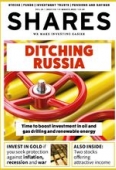Archived article
Please note that tax, investment, pension and ISA rules can change and the information and any views contained in this article may now be inaccurate.
Gold could protect your wealth in difficult times such as now

Gold is on the cusp of setting a new all-time high amid rampant inflation, fears of an economic downturn and war in Ukraine. The precious metal is proving its ‘safe-haven’ credentials in a crisis yet again.
In this article we discuss the prospects for gold, how it compares with other assets, and how you can gain exposure to this traditional store of value as part of a diversified portfolio.
WHY HAS THE PRICE SHOT UP RECENTLY?
Gold prices were already rising before Russia invaded Ukraine, but it was this act which saw prices move within sight of a new record as many investors sought to park their money into something other than shares amid a falling market.
The previous high of $2,072.50 per ounce was marked less than two years ago in August 2020 at the height of the coronavirus pandemic.

GOLD STARTED TO SHINE IN 2019
Arguably gold has been on an upward path since the beginning of 2019 when Brexit, tensions between the US and China, and the US Federal Reserve’s decision to start cutting interest rates dominated the market’s attention.
Gold, which has very limited practical applications, tends to be in demand during periods of economic or geopolitical strife, when inflation threatens paper currencies or there are significant falls in bond and equity markets.

Its status as a safe-haven asset is based on its historic role as a store of value and the fact that, unlike currencies, its value cannot be manipulated through adjustments to interest rates.
It is also rare and tightly supplied, you can’t create it at will, and as Adrian Ash director of research at gold trading platform BullionVault notes ‘it won’t go bust on you’.
Could Russia sell its gold?
According to the International Monetary Fund, Russia had more than 2,000 tonnes of gold as at the end of January and is the fifth largest sovereign holder of gold in the world.
There is speculation the country might sell some of these gold reserves to ease the enormous financial pressures it is under thanks to sanctions.
Any sale is likely to happen off-market, given the risks for mainstream buyers of dealing with Russia, so it wouldn’t hit global flows of the metal, but it could still impact sentiment. China is flagged as possible purchaser as it looks to build its own gold reserves.
IS BITCOIN THE NEW GOLD?
In recent times there has been a debate in some quarters over whether gold might be usurped by an alternative asset like bitcoin.
The cryptocurrency has fans who would argue it shares some of gold’s qualities in being scarce and not easily reproduced, but can an asset which has traded as high as $50,000 and as low as $25,000 in a matter of months really be construed as a safe place to put your money?

BullionVault’s Ash says there is ‘absolutely no evidence bitcoin ate into gold investment flows’ and adds that the two couldn’t be more different as ‘gold is the most physical of tradeable assets’.
GOLD HAS A TRACK RECORD
Unlike bitcoin, gold also has a track record of performing through several crises. Often when a market correction is at its height gold will be sold too, given it becomes one of the few liquid assets available to market traders which can be offloaded without taking too much of a financial hit.
You saw this pattern in the 2007/8 financial crisis and the Covid-19 pandemic. Though on both occasions gold fell less than the wider market and, once the initial indiscriminate selling was out of the way, the metal price then enjoyed a strong run.
The CEO of gold explorer Greatland Gold (GGP:AIM) Shaun Day comments: ‘I think we’ve seen gold over the last five years really return to being that store of value through global volatility, be that economic or geopolitical.’
Day adds: ‘With that combination of economic volatility amplified by geopolitical uncertainty, in particular the Russian war in Ukraine, but also the role that China plays in the world, it adds up to a more volatile universe that we live in, and I think those things should make you feel very confident about the sense of having gold as part of a diversified portfolio.’
He also highlights the return of inflation as being in gold’s favour. BullionVault’s Ash says if we see stagflation – where rising prices are accompanied by a slump in the economy – ‘this is probably the ideal environment for gold thanks to its relationship with real interest rates’.

PROTECTION AGAINST STAGFLATION
By ‘real’ rates, Ash means they have been adjusted for inflation. When real rates are rising, holding a non-interest paying asset like gold is less attractive. However, central banks are constrained from increasing rates too far, too fast against a backdrop of substantial government, corporate and consumer debt and economic uncertainty despite inflation hitting multi-year highs.
Therefore, real interest rates are currently negative and look set to remain so for the foreseeable future. ‘The persistence of historically low interest rates in a high-inflation environment should be supportive for the price of both gold and silver,’ says investment bank Berenberg.
CAN THE PRICE GO HIGHER?
Given gold is close to a record, is there a risk that by investing in the precious metal at current levels you are buying at the top? BullionVault’s Ash says this is a fair question.
He notes that if you bought gold at the start of the 1980s when Russia’s invasion of Afghanistan, revolution in Iran and surging inflation drove the price to $850 per ounce, you would still be out
of pocket in real terms today – i.e. taking into account inflation.
Gold should act as an insurance policy. It could help you when markets are struggling but equally could lag when equities are rallying. The accompanying chart shows how gold has performed relative to the MSCI World index, a popular benchmark for global equities.
While there are no guarantees, Ash believes the drivers for gold are there to sustain prices in the medium to long term.

HOW TO INVEST IN GOLD
There are many ways to invest in gold. You can buy physical gold online through a specialist platform like BullionVault. This allows you to buy physical gold bars which are then stored in vaults in London and other locations including Zurich and New York. You can sell or withdraw your bars without any penalty.
Another way of gaining direct exposure to the gold price is through buying shares in a gold exchange-traded fund, which would typically be backed by physical bullion held in a segregated account. There are several products available on the UK stock market but the cheapest among those with a large amount of assets is Invesco Physical Gold (SGLP) which has an ongoing charge of 0.12%.
An alternative route is to invest in gold miners, whose revenue and profit are boosted by higher gold prices, assuming they haven’t locked into fixed-price sales contracts.
Historically, gold miners have often outperformed a rising gold price. When the gold price is falling, miners can decline by a greater amount.
Gold miners also offer the potential for income, which is not available by directly investing in gold.
Diversified exposure to gold mining stocks is possible through ETFs and funds. Examples include iShares Gold Producers (SPGP), which tracks a basket of the largest companies involved in the exploration and production of gold, for an ongoing charge of 0.55%. The ETF has delivered a five-year annualised return of 11%.
Among the more established actively managed funds is BlackRock Gold and General (B5ZNJ89), however it has lagged the iShares gold mining ETF with an annualised return of 7.4% over the same five-year period.
Investment trust Golden Prospect Precious Metals (GPM) invests in a portfolio of 49 gold and silver miners. It trades at a 16.4% discount to net asset value but has a high ongoing charge of 2.07% according to Morningstar.
In terms of buying individual company shares, the ranks of London-listed gold miners have been hit by a huge sell-off in Russian gold producers Polymetal (POLY) and Petropavlovsk (POG) since the invasion of Ukraine. Egypt-focused Centamin (CEY) carries the risk of being reliant on a single asset in a jurisdiction which itself has not always been stable.
West African gold miner Endeavour Mining (EDV) will be promoted to the FTSE 100 index on 21 March. The company has moved from the development stage to meaningful production, supporting strong free cash flow and dividends.
Berenberg forecasts 2022 output of around 1.4 million ounces at an all-in sustaining cost, a widely used measure of the cost of operations, of $878 per ounce. This should result in healthy margins at current gold prices.
Important information:
These articles are provided by Shares magazine which is published by AJ Bell Media, a part of AJ Bell. Shares is not written by AJ Bell.
Shares is provided for your general information and use and is not a personal recommendation to invest. It is not intended to be relied upon by you in making or not making any investment decisions. The investments referred to in these articles will not be suitable for all investors. If in doubt please seek appropriate independent financial advice.
Investors acting on the information in these articles do so at their own risk and AJ Bell Media and its staff do not accept liability for losses suffered by investors as a result of their investment decisions.
Issue contents
Editor's View
Feature
Great Ideas
- Tharisa shares hit new record high as metal prices rally
- Why Hill & Smith’s share price has fallen too far
- Fancy 9% dividend yield? M&G is the answer
- Hargreaves Services delights investors by raising its full year outlook again
- Buy this Canadian fund for income and exposure to attractive sectors
- Don’t panic about drop in Heptagon European fund
News
- Quality growth strategy delivered strong returns in 2021 for Smithson
- Sanctions create potential earnings boost for non-Russian potash producers
- Mike Ashley increases Frasers’ stake in German fashion retailer Hugo Boss
- Why global shares could receive a major boost from large pension fund rebalancing
- Investors in China should brace for even greater volatility as risks multiply

 magazine
magazine








